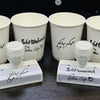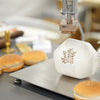Heat Stamps: The Ultimate Tool for Precision, Branding, and Quality
- Posted by M. Azhar Ameen
- 0 comments

In the world of manufacturing, branding, and product customization, a heat stamp might not be the first tool that comes to mind, but it has quietly become an essential asset across various industries. Whether you’re running a business that requires consistent branding, personalizing products, or working with high-end materials, a heat stamp provides an efficient and lasting way to leave an impression.
But what exactly is a heat stamp, and why has it become so indispensable? Let’s take a closer look at the world of heat stamps, exploring their function, applications, benefits, and how they’re transforming industries.
What is a Heat Stamp?
A heat stamp is a tool used to apply a design, logo, or mark onto a surface by using heat and pressure. This process, known as heat stamping or hot stamping, involves a heated die or metal plate that is pressed against the material. The heat causes the material to soften and accept the imprint, while pressure ensures the design is transferred clearly and evenly. The heat can also cause certain inks or foils to adhere to the material, creating vibrant, metallic, or embossed finishes.
Heat stamping is commonly used on a wide variety of materials, including paper, leather, plastics, wood, and textiles. The versatility of heat stamps has made them a popular choice in a range of industries, from fashion to manufacturing, packaging, and even art.
The Process of Heat Stamping
The heat stamping process involves several key steps, each of which plays a crucial role in achieving a clean and precise result.
-
Design Creation: The first step is creating a design or logo that will be stamped. The design can be anything from a simple text to complex artwork or patterns. The design is transferred to a die (typically made of metal) or a plate that will carry the heat.
-
Heating the Die: The die or plate is heated to a precise temperature. The temperature can vary depending on the material being stamped, as different materials require different levels of heat for optimal adhesion.
-
Pressure Application: Once the die reaches the correct temperature, it is pressed against the material. The pressure and heat combine to transfer the design onto the surface, leaving an imprint that’s both visible and durable.
-
Cooling and Finishing: After the stamp is applied, the material is allowed to cool. Depending on the process, additional finishes such as coating, foiling, or embossing may be applied to enhance the final result.
Types of Heat Stamps
There are various types of heat stamps, each suited for different applications and materials. Here are some of the most common types:
1. Flatbed Heat Stamps
Flatbed heat stamping machines feature a flat surface that presses a heated die onto the material. These are commonly used for items like printed documents, labels, packaging, and other flat objects. Flatbed machines are versatile and can be used for both high-volume production and custom, small-batch runs.
2. Rotary Heat Stamps
Rotary heat stamps are used for continuous or high-speed stamping on cylindrical or rolled materials. These are often used in industries like textiles, where fabric rolls need to be stamped with logos, designs, or patterns. The rotary design allows for faster, more efficient production.
3. Manual Heat Stamps
Manual heat stamps are handheld devices that are used to apply heat and pressure to a specific area. These are often used in small-scale operations, workshops, or for custom work where precision and a personal touch are needed. Manual heat stamps are easy to use and offer great flexibility.
4. Foil Stamping
Foil stamping is a specialized form of heat stamping that uses metallic foil to create shiny, glossy designs on materials like paper, leather, and plastics. Foil stamping is often used in luxury packaging, invitations, and branding to create a high-end, eye-catching effect.
Applications of Heat Stamps
Heat stamps are used in a wide array of industries, each benefiting from the precision and efficiency they offer. Below are some of the key applications of heat stamps:
1. Branding and Packaging
One of the most common uses of heat stamps is for branding and labeling. Companies use heat stamping to create customized packaging, product labels, and even clothing tags. A logo or design that’s heat-stamped onto packaging not only adds a premium look to the product but also creates a lasting impression on consumers. This method is especially popular in the fashion industry, where heat stamps are used to brand leather goods, wallets, belts, and handbags.
2. Leather and Textile Industries
Heat stamps are widely used in the leather industry for creating personalized or branded products such as wallets, belts, shoes, and bags. In textile manufacturing, heat stamps can be used to apply logos, patterns, or text to fabric materials. This is especially important in the creation of designer clothing, accessories, and custom textiles. The ability to apply logos and designs in a durable, high-quality way makes heat stamping a staple in both luxury and everyday fashion items.
3. Paper and Stationery
Heat stamping is a popular method for customizing paper products, especially in the stationery, greeting card, and packaging industries. Whether it’s for embossing a wedding invitation, adding a company logo to a box, or creating decorative paper for gift wrapping, heat stamping provides an elegant and timeless finish. Foil stamping, in particular, is often used for premium and high-end paper products, providing a touch of luxury and exclusivity.
4. Automotive and Aerospace Industries
In the automotive and aerospace industries, heat stamping is employed for marking or labeling parts and components. For instance, manufacturers use heat stamps to apply serial numbers, logos, and quality control marks onto metal parts, ensuring traceability and compliance with industry standards. The process provides a durable, long-lasting imprint that can withstand harsh environmental conditions, including high temperatures, moisture, and friction.
5. Consumer Goods and Electronics
Heat stamping is also used in the consumer goods and electronics sectors, especially for branding or product identification purposes. For example, it can be used to mark serial numbers, product names, and safety warnings on electronics, ensuring compliance and offering brand recognition. In addition, heat stamping is used to create custom logos on various consumer goods, from small appliances to sporting equipment.
6. Art and Customization
Heat stamps are also an invaluable tool in the world of art and customization. Many artists use heat stamps to create intricate designs on a variety of materials, including wood, leather, and fabric. Whether for creating personalized gifts, custom signage, or unique furniture pieces, heat stamps allow for the creation of highly detailed and permanent designs.
Benefits of Using Heat Stamps
There are several advantages to using heat stamps over other types of marking or branding methods:
1. Precision and Consistency
Heat stamping delivers precise, consistent results. Whether you’re stamping small logos on clothing tags or large designs on packaging, the level of detail and accuracy is maintained throughout the production process.
2. Durability
Heat-stamped designs are incredibly durable. Unlike ink printing or stickers, heat stamping creates a permanent imprint that won’t fade, peel, or wash away over time. This makes it ideal for products that need to stand up to wear and tear, such as leather goods, textiles, or automotive parts.
3. High-Quality Appearance
The process of heat stamping, particularly foil stamping, adds a high-quality, professional finish to products. It’s a cost-effective way to create a premium look without the need for expensive processes like embossing or full-color printing.
4. Versatility
Heat stamping can be used on a wide range of materials, including paper, leather, wood, textiles, plastics, and metals. This versatility makes it an ideal solution for various industries, from fashion to manufacturing.
5. Efficiency
Heat stamping is fast and efficient, especially when used in high-volume manufacturing environments. It reduces the time and labor required for branding or customizing products, making it an excellent choice for businesses looking to scale up their production without sacrificing quality.
Conclusion
Heat stamps are a simple yet powerful tool that has revolutionized branding, customization, and manufacturing across various industries. Whether you're looking to create personalized products, apply logos and designs, or improve the visual appeal of your items, heat stamping offers a durable, efficient, and cost-effective solution.
From the fashion industry to automotive manufacturing, from packaging to art, heat stamps offer versatility and precision that other methods simply can't match. By combining heat, pressure, and design, businesses can create high-quality, long-lasting imprints that leave a lasting impression on customers and consumers alike. If you're looking to elevate your brand, enhance your products, or streamline your production processes, heat stamping is a tool you won’t want to overlook.





